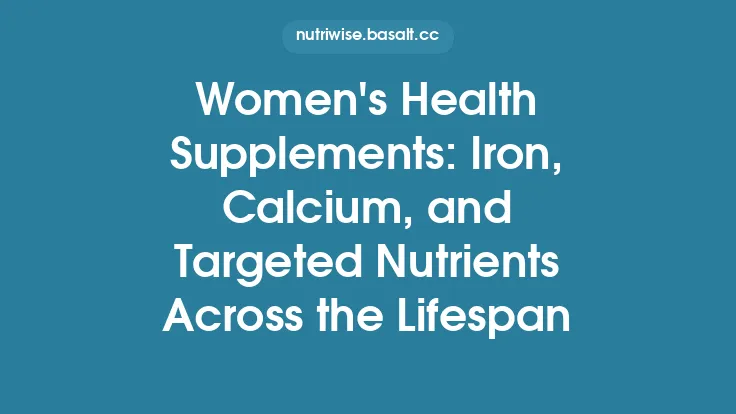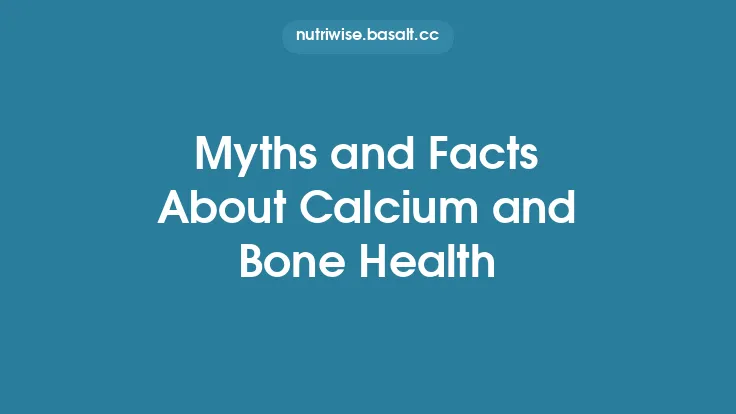Calcium is the most abundant mineral in the human body, and its relationship with the skeletal system is a cornerstone of overall health. While many people recognize calcium as the “bone mineral,” its functions extend far beyond simply providing structural support. Understanding how calcium works, how much you need, and the best ways to obtain and use it can empower you to maintain strong bones throughout life.
The Biological Role of Calcium in the Skeletal System
Calcium exists in two primary pools within the body: an extracellular pool (about 1 % of total body calcium) that circulates in the blood and interstitial fluid, and an intracellular pool (about 99 %) stored mainly in bone and teeth. The extracellular calcium concentration is tightly regulated because it is essential for:
- Neuromuscular transmission – calcium ions trigger the release of neurotransmitters at synaptic junctions and initiate muscle contraction.
- Blood coagulation – several clotting factors require calcium as a co‑factor to convert fibrinogen to fibrin.
- Cellular signaling – calcium acts as a second messenger in pathways that control hormone secretion, enzyme activity, and gene expression.
In bone, calcium is combined with phosphate to form hydroxyapatite crystals (Ca₁₀(PO₄)₆(OH)₂), which give the mineralized matrix its hardness and resistance to compression. Approximately 99 % of the body’s calcium is locked within this crystalline lattice, providing the structural framework that supports the body’s weight and protects vital organs.
Bone Remodeling: How Calcium Contributes to Formation and Resorption
Bone is a dynamic tissue that undergoes continuous remodeling—a balanced cycle of resorption (breakdown) by osteoclasts and formation by osteoblasts. This process serves several purposes:
- Repair microdamage caused by everyday mechanical stress.
- Adapt to mechanical loading, strengthening areas subjected to higher forces (Wolff’s law).
- Regulate calcium homeostasis by releasing calcium into the bloodstream when dietary intake is insufficient.
During resorption, osteoclasts create an acidic microenvironment that dissolves hydroxyapatite, releasing calcium and phosphate into the extracellular fluid. Osteoblasts then lay down new collagen matrix (osteoid) and subsequently mineralize it with calcium and phosphate. The net balance of these activities determines whether bone mass is maintained, gained, or lost.
Calcium availability directly influences the mineralization phase. If extracellular calcium is low, osteoblasts cannot fully mineralize the osteoid, leading to osteomalacia in adults (softening of bone) or rickets in children. Conversely, adequate calcium supplies support robust mineral deposition and optimal bone density.
Recommended Dietary Allowances (RDAs) and Upper Limits for Calcium
The Institute of Medicine (now the National Academy of Medicine) provides age‑ and sex‑specific RDAs for calcium, reflecting the varying needs across the lifespan:
| Age / Life Stage | RDA (mg/day) | Tolerable Upper Intake Level (UL) |
|---|---|---|
| 0–6 months | 200 | 1,000 |
| 7–12 months | 260 | 1,000 |
| 1–3 years | 700 | 2,500 |
| 4–8 years | 1,000 | 2,500 |
| 9–18 years (rapid growth) | 1,300 | 2,500 |
| 19–50 years (both sexes) | 1,000 | 2,500 |
| 51–70 years (men) | 1,000 | 2,500 |
| 51–70 years (women) | 1,200 | 2,500 |
| 71+ years (both sexes) | 1,200 | 2,000 |
The UL represents the maximum daily intake unlikely to cause adverse health effects. Chronic consumption above the UL can increase the risk of hypercalcemia, kidney stone formation, and interference with the absorption of other minerals (e.g., iron, zinc). It is therefore advisable to aim for the RDA through a combination of diet and, when necessary, supplementation.
Food Sources Rich in Calcium and Bioavailability Considerations
A varied diet can comfortably meet most individuals’ calcium needs. Below are common sources, grouped by their typical calcium density and bioavailability:
| Food Category | Approx. Calcium (mg per serving) | Bioavailability Notes |
|---|---|---|
| Dairy (milk, yogurt, cheese) | 300–350 (1 cup milk) | High; casein and lactose enhance absorption |
| Fortified plant milks (soy, almond, oat) | 300–450 (1 cup) | Comparable to dairy when fortified; check for added vitamin D |
| Leafy greens (collard greens, kale) | 150–250 (½ cup cooked) | Calcium bound to oxalates in spinach reduces absorption; kale and collards are better |
| Canned fish with bones (salmon, sardines) | 180–200 (3 oz) | Highly bioavailable; bones are soft and edible |
| Tofu (calcium‑set) | 250–350 (½ cup) | Depends on coagulant; calcium sulfate yields higher calcium |
| Legumes & nuts (white beans, almonds) | 80–100 (½ cup beans) | Moderate; phytic acid can inhibit absorption but cooking reduces it |
| Fortified cereals & juices | 100–300 (1 cup) | Varies; often paired with vitamin D to aid absorption |
Bioavailability factors
- Oxalates and phytates: Compounds that bind calcium, forming insoluble complexes. Cooking, soaking, or fermenting can reduce their impact.
- Animal protein: Moderate amounts can increase calcium absorption by enhancing intestinal calcium transport, but very high protein intakes may increase urinary calcium excretion.
- Acidic environment: Consuming calcium with a source of acidity (e.g., citrus juice) can improve solubility and uptake.
Factors Influencing Calcium Absorption and Utilization
Even with adequate intake, several physiological and lifestyle variables dictate how much calcium actually reaches the bloodstream:
- Age – Intestinal calcium absorption efficiency declines from ~30 % in infants to ~10–15 % in older adults.
- Hormonal status – Parathyroid hormone (PTH) and calcitonin tightly regulate calcium balance. Postmenopausal estrogen decline can increase bone resorption, indirectly affecting calcium needs.
- Vitamin D status – Although the focus of this article is calcium, it is worth noting that the active form, 1,25‑dihydroxyvitamin D, upregulates calcium transport proteins in the gut. Adequate vitamin D levels (generally 30–50 ng/mL serum 25‑OH D) are essential for optimal calcium absorption.
- Gastrointestinal health – Conditions such as celiac disease, inflammatory bowel disease, or chronic use of proton‑pump inhibitors can impair calcium uptake.
- Dietary composition – High sodium intake increases urinary calcium loss; excessive caffeine (≥300 mg/day) can have a modest diuretic effect on calcium.
- Physical activity – Weight‑bearing and resistance exercises stimulate osteoblastic activity, enhancing the incorporation of calcium into bone.
Calcium Supplement Forms: Pros, Cons, and Choosing the Right Product
When dietary intake falls short, supplements can bridge the gap. The most common calcium salts differ in elemental calcium content, solubility, and gastrointestinal tolerance:
| Calcium Salt | Elemental Calcium (% of weight) | Solubility (pH 7) | Typical Uses | Advantages | Potential Drawbacks |
|---|---|---|---|---|---|
| Calcium carbonate | ~40 % | Low (requires acidic environment) | General supplementation | Inexpensive, high elemental calcium per tablet | May cause constipation; less absorbed if taken without food |
| Calcium citrate | ~21 % | High (well absorbed with or without food) | Patients on acid‑suppressing meds, older adults | Gentle on stomach, less constipating | Requires larger pill size for equivalent calcium |
| Calcium gluconate | ~9 % | Very high solubility | Intravenous therapy, specific medical conditions | Minimal GI upset | Low elemental calcium; many tablets needed |
| Calcium lactate | ~13 % | Moderate | Occasionally used in fortified foods | Good taste, easy dissolution | Lower calcium density |
| Calcium phosphate (hydroxyapatite) | ~39 % | Low | Dental and bone health formulations | Provides both calcium and phosphate | May be less bioavailable than citrate |
Choosing a supplement
- Absorption needs: Individuals on proton‑pump inhibitors or with reduced stomach acidity benefit from calcium citrate.
- Tolerance: Those prone to constipation may prefer citrate or a split dose of smaller tablets.
- Convenience: For those who dislike swallowing large pills, chewable or liquid formulations (often citrate‑based) are available.
- Cost: Calcium carbonate is the most economical, but the price difference is modest for most consumers.
Timing, Dosage, and Co‑Administration Strategies for Optimal Absorption
Calcium absorption is dose‑dependent; the intestine efficiently absorbs up to ~500 mg at a time. Larger single doses result in diminishing returns and may increase the risk of gastrointestinal discomfort. Practical recommendations:
- Split the total daily dose into 2–3 servings (e.g., 500 mg with breakfast, 500 mg with dinner).
- Take calcium carbonate with meals to ensure adequate gastric acidity for dissolution.
- Calcium citrate can be taken anytime, but pairing with a meal may improve overall nutrient synergy.
- Avoid high‑dose calcium with iron or zinc supplements within the same window, as they compete for absorption pathways. Space them at least 2 hours apart.
- Maintain adequate hydration to reduce the risk of kidney stone formation, especially when consuming higher calcium amounts.
Special Populations: Children, Adolescents, Postmenopausal Women, and the Elderly
Children (1–8 years)
- Rapid skeletal growth demands high calcium relative to body size.
- Aim for the RDA through dairy or fortified alternatives; supplement only if dietary intake is consistently low.
Adolescents (9–18 years)
- Peak bone mass accrual occurs during this window; achieving optimal calcium status can reduce future fracture risk.
- Encourage calcium‑rich snacks (e.g., yogurt, cheese sticks) and regular weight‑bearing activity.
Pregnant and Lactating Women
- Calcium needs rise modestly (≈1,000 mg/day) to support fetal bone development and milk production.
- Adequate intake protects maternal bone density; supplementation is rarely required if diet is sufficient.
Postmenopausal Women
- Estrogen decline accelerates bone resorption. Calcium (1,200 mg/day) combined with adequate vitamin D and resistance training is a cornerstone of osteoporosis prevention.
- Consider calcium citrate if gastrointestinal tolerance is an issue.
Older Adults (≥70 years)
- Reduced intestinal absorption and higher fracture risk necessitate meeting the higher RDA (1,200 mg/day).
- Monitor for hypercalcemia if using calcium‑containing antacids or high‑dose supplements; periodic serum calcium checks are prudent.
Potential Risks of Excess Calcium Intake and How to Mitigate Them
While calcium is essential, excess intake can have adverse consequences:
- Hypercalcemia – Symptoms include fatigue, nausea, polyuria, and in severe cases, cardiac arrhythmias. It is usually linked to over‑supplementation, especially when combined with high vitamin D doses.
- Kidney stones – Calcium oxalate stones are the most common type; high urinary calcium can predispose susceptible individuals. Adequate fluid intake (≥2 L/day) and balanced oxalate consumption help mitigate risk.
- Cardiovascular concerns – Some observational studies have suggested a link between very high calcium supplement intake and arterial calcification, though randomized trials have not confirmed a causal relationship. Staying within the UL and preferring dietary calcium over excessive supplementation is advisable.
- Interference with other minerals – Excess calcium can reduce absorption of iron, zinc, and magnesium. Rotating supplement timing and ensuring a varied diet can prevent deficiencies.
Monitoring Bone Health: Biomarkers, Imaging, and Clinical Assessment
Effective bone health management involves periodic evaluation:
- Dual‑energy X‑ray absorptiometry (DXA) – Gold standard for measuring bone mineral density (BMD) at the hip and spine. Results are expressed as T‑scores (comparison to young adult mean) and Z‑scores (age‑matched reference).
- Serum markers –
- *Bone formation*: osteocalcin, procollagen type 1 N‑terminal propeptide (P1NP).
- *Bone resorption*: C‑terminal telopeptide (CTX), N‑terminal telopeptide (NTX).
These markers can reflect short‑term changes in bone turnover, useful for monitoring therapy response.
- Serum calcium and 25‑hydroxyvitamin D – Ensure levels are within normal ranges before initiating high‑dose calcium supplementation.
- Fracture risk calculators – Tools such as FRAX incorporate age, sex, BMD, and clinical risk factors to estimate 10‑year probability of major osteoporotic fracture.
Regular assessment (every 2–5 years for average‑risk adults; more frequently for high‑risk groups) enables timely adjustments to calcium intake, lifestyle, or pharmacologic interventions.
Integrating Calcium with Lifestyle Practices for Long‑Term Skeletal Health
Calcium alone cannot guarantee bone strength; a holistic approach yields the best outcomes:
- Weight‑bearing exercise – Activities like walking, jogging, dancing, and resistance training stimulate osteoblast activity and improve bone geometry. Aim for at least 150 minutes of moderate‑intensity activity weekly, plus two strength‑training sessions.
- Adequate protein – 0.8–1.0 g/kg body weight per day supports collagen matrix formation; higher intakes (1.2–1.5 g/kg) are beneficial for older adults engaged in resistance training.
- Balanced micronutrient intake – Ensure sufficient magnesium, phosphorus, and vitamin K2 (found in fermented foods) to support mineralization and calcium placement in bone rather than soft tissue.
- Limit excessive sodium and caffeine – High sodium (>2,300 mg/day) increases urinary calcium loss; moderate caffeine (<300 mg/day) has a modest effect but can be offset by adequate calcium intake.
- Avoid smoking and excessive alcohol – Both are linked to accelerated bone loss and increased fracture risk.
By aligning dietary calcium with these lifestyle factors, you create a synergistic environment that maximizes bone density, reduces fracture risk, and promotes overall musculoskeletal resilience.
In summary, calcium is a pivotal mineral for bone health, influencing everything from the microscopic architecture of hydroxyapatite crystals to the macroscopic strength of the skeleton. Meeting age‑appropriate calcium needs through a combination of nutrient‑dense foods and, when necessary, well‑chosen supplements—while paying attention to absorption enhancers, timing, and overall lifestyle—provides a solid foundation for lifelong skeletal health. Regular monitoring and individualized adjustments ensure that calcium remains a beneficial ally rather than a source of excess, helping you maintain strong bones at every stage of life.





